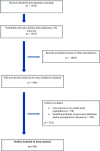Selective-versus-Standard Poststent Dilation for Carotid Artery Disease: A Systematic Review and Meta-Analysis
- PMID: 28302610
- PMCID: PMC7960390
- DOI: 10.3174/ajnr.A5103
Selective-versus-Standard Poststent Dilation for Carotid Artery Disease: A Systematic Review and Meta-Analysis
Abstract
Backround: The safety and efficacy of standard poststent angioplasty in patients undergoing carotid artery stent placement have not been well-established.
Purpose: We conducted a systematic review of the literature to evaluate the safety and efficacy of carotid artery stent placement and analyzed outcomes of standard-versus-selective poststent angioplasty.
Data sources: A systematic search of MEDLINE, EMBASE, Scopus, and the Web of Science was performed for studies published between January 2000 and January 2015.
Study selection: We included studies with >30 patients describing standard or selective poststent angioplasty during carotid artery stent placement.
Data analysis: A random-effects meta-analysis was used to pool the following outcomes: periprocedural stroke/TIA, procedure-related neurologic/cardiovascular morbidity/mortality, bradycardia/hypotension, long-term stroke at last follow-up, long-term primary patency, and technical success.
Data synthesis: We included 87 studies with 19,684 patients with 20,378 carotid artery stenoses. There was no difference in clinical (P = .49) or angiographic outcomes (P = .93) in carotid artery stent placement treatment with selective or standard poststent balloon angioplasty. Both selective and standard poststent angioplasty groups had a very high technical success of >98% and a low procedure-related mortality of 0.9%. There were no significant differences between both groups in the incidence of restenosis (P = .93) or procedure-related complications (P = .37).
Limitations: No comparison to a patient group without poststent dilation could be performed.
Conclusions: Our meta-analysis demonstrated no significant difference in angiographic and clinical outcomes among series that performed standard poststent angioplasty and those that performed poststent angioplasty in only select patients.
© 2017 by American Journal of Neuroradiology.
Figures
Comment in
-
Reply.AJNR Am J Neuroradiol. 2017 Nov;38(11):E98. doi: 10.3174/ajnr.A5435. Epub 2017 Oct 19. AJNR Am J Neuroradiol. 2017. PMID: 29051206 Free PMC article. No abstract available.
-
Selective Poststent Balloon Angioplasty for Carotid Stenting.AJNR Am J Neuroradiol. 2017 Nov;38(11):E97. doi: 10.3174/ajnr.A5346. Epub 2017 Oct 19. AJNR Am J Neuroradiol. 2017. PMID: 29051210 Free PMC article. No abstract available.
Similar articles
-
Percutaneous transluminal angioplasty and stenting for carotid artery stenosis.Cochrane Database Syst Rev. 2004;(2):CD000515. doi: 10.1002/14651858.CD000515.pub2. Cochrane Database Syst Rev. 2004. Update in: Cochrane Database Syst Rev. 2007 Oct 17;(4):CD000515. doi: 10.1002/14651858.CD000515.pub3. PMID: 15106153 Updated.
-
Balloon angioplasty compared with stenting for treatment of femoropopliteal occlusive disease: a meta-analysis.J Vasc Surg. 2008 Feb;47(2):461-9. doi: 10.1016/j.jvs.2007.07.059. Epub 2007 Oct 22. J Vasc Surg. 2008. PMID: 17950563
-
Bypass surgery for chronic lower limb ischaemia.Cochrane Database Syst Rev. 2017 Apr 3;4(4):CD002000. doi: 10.1002/14651858.CD002000.pub3. Cochrane Database Syst Rev. 2017. PMID: 28368090 Free PMC article.
-
Systemic pharmacological treatments for chronic plaque psoriasis: a network meta-analysis.Cochrane Database Syst Rev. 2021 Apr 19;4(4):CD011535. doi: 10.1002/14651858.CD011535.pub4. Cochrane Database Syst Rev. 2021. Update in: Cochrane Database Syst Rev. 2022 May 23;5:CD011535. doi: 10.1002/14651858.CD011535.pub5. PMID: 33871055 Free PMC article. Updated.
-
Duplex ultrasound for diagnosing symptomatic carotid stenosis in the extracranial segments.Cochrane Database Syst Rev. 2022 Jul 11;7(7):CD013172. doi: 10.1002/14651858.CD013172.pub2. Cochrane Database Syst Rev. 2022. PMID: 35815652 Free PMC article.
Cited by
-
Poststent ballooning during transcarotid artery revascularization.J Vasc Surg. 2021 Jun;73(6):2041-2049.e1. doi: 10.1016/j.jvs.2020.10.071. Epub 2020 Nov 27. J Vasc Surg. 2021. PMID: 33253868 Free PMC article.
-
Reply.AJNR Am J Neuroradiol. 2017 Nov;38(11):E98. doi: 10.3174/ajnr.A5435. Epub 2017 Oct 19. AJNR Am J Neuroradiol. 2017. PMID: 29051206 Free PMC article. No abstract available.
-
Selective Poststent Balloon Angioplasty for Carotid Stenting.AJNR Am J Neuroradiol. 2017 Nov;38(11):E97. doi: 10.3174/ajnr.A5346. Epub 2017 Oct 19. AJNR Am J Neuroradiol. 2017. PMID: 29051210 Free PMC article. No abstract available.
References
-
- Ederle J, Bonati LH, Dobson J, et al. ; CAVATAS Investigators. Endovascular treatment with angioplasty or stenting versus endarterectomy in patients with carotid artery stenosis in the Carotid and Vertebral Artery Transluminal Angioplasty Study (CAVATAS): long-term follow-up of a randomised trial. Lancet Neurol 2009;8:898–907 10.1016/S1474-4422(09)70228-5 - DOI - PMC - PubMed
-
- Ederle J, Dobson J, Featherstone RL, et al. ; International Carotid Stenting Study investigators. Carotid artery stenting compared with endarterectomy in patients with symptomatic carotid stenosis (International Carotid Stenting Study): an interim analysis of a randomised controlled trial. Lancet 2010;375:985–97 10.1016/S0140-6736(10)60239-5 - DOI - PMC - PubMed
Publication types
MeSH terms
LinkOut - more resources
Full Text Sources
Other Literature Sources

